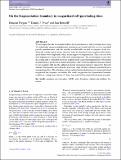Files in this item
On the fragmentation boundary in magnetized self-gravitating discs
Item metadata
| dc.contributor.author | Forgan, Duncan | |
| dc.contributor.author | Price, Daniel J. | |
| dc.contributor.author | Bonnell, Ian | |
| dc.date.accessioned | 2017-05-19T11:30:10Z | |
| dc.date.available | 2017-05-19T11:30:10Z | |
| dc.date.issued | 2017-04 | |
| dc.identifier | 250036018 | |
| dc.identifier | e3a9011c-d35d-461d-8a5b-529199aa6702 | |
| dc.identifier | 85018365259 | |
| dc.identifier | 000398418600063 | |
| dc.identifier.citation | Forgan , D , Price , D J & Bonnell , I 2017 , ' On the fragmentation boundary in magnetized self-gravitating discs ' , Monthly Notices of the Royal Astronomical Society , vol. 466 , no. 3 , pp. 3406-3416 . https://doi.org/10.1093/mnras/stw3314 | en |
| dc.identifier.issn | 0035-8711 | |
| dc.identifier.uri | https://hdl.handle.net/10023/10800 | |
| dc.description | DHF and IAB gratefully acknowledge support from the ECOGAL project, grant agreement 291227, funded by the European Research Council under ER-2011-ADG. DJP gratefully acknowledges funding via grants DP130102078 and FT130100034 and via Future Fellowship FT130100034 from the Australian Research Council. | en |
| dc.description.abstract | We investigate the role of magnetic fields in the fragmentation of self-gravitating discs using 3D global ideal magnetohydrodynamic simulations performed with the PHANTOM smoothed particle hydrodynamics code. For initially toroidal fields, we find two regimes. In the first, where the cooling time is greater than five times the dynamical time, magnetic fields reduce spiral density wave amplitudes, which in turn suppresses fragmentation. This is the case even if the magnetic pressure is only a 10th of the thermal pressure. The second regime occurs when the cooling time is sufficiently short that magnetic fields cannot halt fragmentation.We find that magnetized discs produce more massive fragments, due to both the additional pressure exerted by the magnetic field and the additional angular momentum transport induced by Maxwell stresses. The fragments are confined to a narrower range of initial semimajor axes than those in unmagnetized discs. The orbital eccentricity and inclination distributions of unmagnetized and magnetized disc fragments are similar. Our results suggest that the fragmentation boundary could be at cooling times a factor of 2 lower than predicted by purely hydrodynamical models. | |
| dc.format.extent | 11 | |
| dc.format.extent | 2330985 | |
| dc.language.iso | eng | |
| dc.relation.ispartof | Monthly Notices of the Royal Astronomical Society | en |
| dc.subject | Accretion: accretion discs | en |
| dc.subject | Stars: formation | en |
| dc.subject | Quasars: supermassive black holes | en |
| dc.subject | Planets and satellites: formation | en |
| dc.subject | Magnetohydrodynamics (MHD) | en |
| dc.subject | QB Astronomy | en |
| dc.subject | QC Physics | en |
| dc.subject | Astronomy and Astrophysics | en |
| dc.subject | Space and Planetary Science | en |
| dc.subject | NDAS | en |
| dc.subject.lcc | QB | en |
| dc.subject.lcc | QC | en |
| dc.title | On the fragmentation boundary in magnetized self-gravitating discs | en |
| dc.type | Journal article | en |
| dc.contributor.sponsor | European Research Council | en |
| dc.contributor.institution | University of St Andrews. School of Physics and Astronomy | en |
| dc.contributor.institution | University of St Andrews. St Andrews Centre for Exoplanet Science | en |
| dc.identifier.doi | 10.1093/mnras/stw3314 | |
| dc.description.status | Peer reviewed | en |
| dc.identifier.url | https://arxiv.org/abs/1612.06145 | en |
| dc.identifier.grantnumber | en |
This item appears in the following Collection(s)
Items in the St Andrews Research Repository are protected by copyright, with all rights reserved, unless otherwise indicated.

